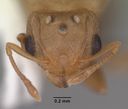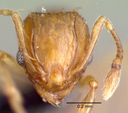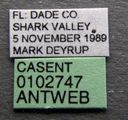Little Fire Ant
Wasmannia auropunctata
Classification
- Phylum: Arthropoda
- Subphylum: Hexapoda
- Class: Insecta
- Order: Hymenoptera
- Superfamily: Formicoidea
- Family: Formicidae
- Subfamily: Myrmicinae
- Tribe: Attini
- Genus: Wasmannia
- Species: auropunctata
Pronunciation
How to pronounce Wasmannia auropunctata: /wɑsˈmæn.i.ə ˌɔː.roʊ.pʌŋkˈtɑː.tə/
These audio files are automatically generated. While they are not always 100% accurate, they are a good starting point.
Images






Summary
Wasmannia auropunctata, commonly known as the little fire ant or electric ant, is a small, invasive ant species originating from Central and South America. It has a significant impact on local ecosystems, agriculture, and human life due to its painful sting and predatory behavior. The ant utilizes unique reproductive strategies including parthenogenesis, complicating its control in introduced areas.
Physical Characteristics
Small to medium-sized, approximately 1.5 mm (1/16 in) long, light to golden brown in color; gaster is often darker. Workers are monomorphic with no physical differentiation. The pedicel has two segments (petiole and postpetiole), with the petiole being hatchet-like in shape. Antennae consist of 11 segments, with the last two segments forming a distinct club. Thorax has long and sharp epinotal spines, and the body is sparsely covered with long, erect hairs.
Identification Tips
Look for small, light to golden brown ants, approximately 1-2 mm in length, with a distinctive painful sting. The petiole has a rectangular profile and is higher than the postpetiole.
Habitat
Habitat generalists commonly found in forest edges, managed forests, agricultural fields, and plantations, particularly in warmer regions associated with human activity.
Distribution
Native to Central and South America, now invasive in parts of Africa (Gabon, Cameroon), Taiwan, North America (notably Florida), Puerto Rico, Israel, Cuba, St. Croix, various Pacific Islands (including the Galápagos Islands, Hawaii, New Caledonia, and Solomon Islands) plus northern Australia (Cairns).
Diet
Omnivorous; consumes other insects, decaying vegetation, seeds, plants, honeydew, and engages in mutualistic relationships with herbivorous insects such as aphids.
Life Cycle
Reproductive systems include both parthenogenesis and sexual reproduction. Queens can produce more queens through parthenogenesis, and sterile workers are produced from eggs fertilized by males. Clonal reproduction is noted, allowing complete separation of male and female gene pools.
Reproduction
Queens reproduce via parthenogenesis (thelytoky) and can produce fertile offspring without fertilization; fertilized eggs from males usually produce sterile workers. Automictic parthenogenesis may also occur.
Ecosystem Role
An effective predator capable of subduing large insects and vertebrate prey, which may impact local biodiversity and decrease native ant diversity.
Economic Impact
Negative impact on agriculture due to stripping of nutrients from crops, resulting in lower yields and increased crop susceptibility to disease and pests. Causes problems for crops in high-density populations.
Health Concerns
Stings can cause painful welts and, in pets, may lead to serious issues such as blindness if stung around the eyes. Potential links to keratopathy in humans.
Collecting Methods
- Using bait traps to attract and capture ants
- Hand collection from nests or foraging trails
Preservation Methods
- Ethanol preservation
- Drying specimens for museum collections
Evolution
Exhibits significant example of clonal reproduction; first recognized case in an animal where both females and males can reproduce clonally.
Similar Taxa
Misconceptions
The pain of the sting may be underestimated due to the small size of the ant; it can be quite intense despite the ant's diminutive appearance.
Tags
- invasive species
- agricultural pest
- ant
- Wasmannia auropunctata
- electric ant